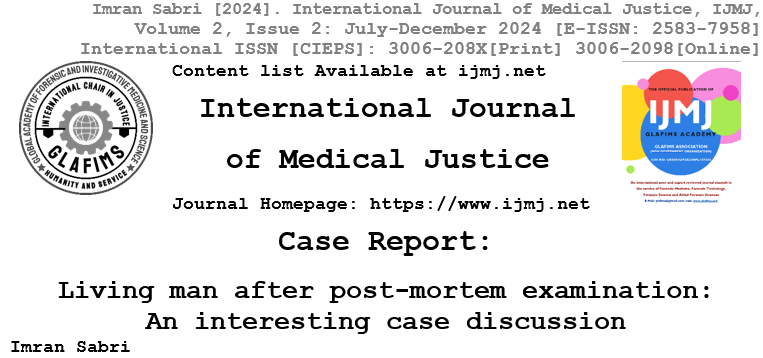Living man after post-mortem examination: An interesting case discussion
DOI:
https://doi.org/10.5281/zenodo.14254128Keywords:
Medical Error, Autopsy, DeathAbstract
A post-mortem examination, also known as an autopsy, is the examination of a body after death. The aim of a post-mortem is to determine the cause of death [1]. One of the fundamental documentation prerequisites for the execution of a post-mortem examination is the formal issuance of a death certificate pertaining to the deceased individual. Throughout this procedure, the possibility of human error may arise because of negligence exhibited by the attending physicians. Such errors may have also propagated to other personnel involved in the process. In this case report, we present an atypical instance of error that can be unequivocally categorized as a “Medicolegal Error.” A 25-year-old male was declared deceased by the hospital, and subsequently, a post-mortem examination was performed. Remarkably, the individual was found to be alive following this intervention. It is deduced that this incident represents a definitive case of Medical Error. In this manuscript, we endeavor to identify the various levels and underlying factors that contributed to this occurrence. Furthermore, we assert that a collective responsibility involving multiple stakeholders is apparent in this context. Finally, we proffer several recommendations aimed at developing future strategies to mitigate or curtail such occurrences of “Medico-legal Errors.”

Downloads
Published
How to Cite
Issue
Section
License
Copyright (c) 2024 International Journal of Medical Justice

This work is licensed under a Creative Commons Attribution 4.0 International License.
Copyright Policy Summary – International Journal of Medical Justice (IJMJ):
IJMJ is an open access journal. All articles are published under the Creative Commons Attribution 4.0 International License (CC BY 4.0). This allows others to freely access, share, reproduce, and create derivative works, provided proper credit is given to the original authors. Authors retain full ownership of their work.

